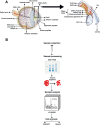Characterizing the normal proteome of human ciliary body
- PMID: 23914977
- PMCID: PMC3750387
- DOI: 10.1186/1559-0275-10-9
Characterizing the normal proteome of human ciliary body
Abstract
Background: The ciliary body is the circumferential muscular tissue located just behind the iris in the anterior chamber of the eye. It plays a pivotal role in the production of aqueous humor, maintenance of the lens zonules and accommodation by changing the shape of the crystalline lens. The ciliary body is the major target of drugs against glaucoma as its inhibition leads to a drop in intraocular pressure. A molecular study of the ciliary body could provide a better understanding about the pathophysiological processes that occur in glaucoma. Thus far, no large-scale proteomic investigation has been reported for the human ciliary body.
Results: In this study, we have carried out an in-depth LC-MS/MS-based proteomic analysis of normal human ciliary body and have identified 2,815 proteins. We identified a number of proteins that were previously not described in the ciliary body including importin 5 (IPO5), atlastin-2 (ATL2), B-cell receptor associated protein 29 (BCAP29), basigin (BSG), calpain-1 (CAPN1), copine 6 (CPNE6), fibulin 1 (FBLN1) and galectin 1 (LGALS1). We compared the plasma proteome with the ciliary body proteome and found that the large majority of proteins in the ciliary body were also detectable in the plasma while 896 proteins were unique to the ciliary body. We also classified proteins using pathway enrichment analysis and found most of proteins associated with ubiquitin pathway, EIF2 signaling, glycolysis and gluconeogenesis.
Conclusions: More than 95% of the identified proteins have not been previously described in the ciliary body proteome. This is the largest catalogue of proteins reported thus far in the ciliary body that should provide new insights into our understanding of the factors involved in maintaining the secretion of aqueous humor. The identification of these proteins will aid in understanding various eye diseases of the anterior segment such as glaucoma and presbyopia.
Figures





Similar articles
-
New perspectives in aqueous humor secretion and in glaucoma: the ciliary body as a multifunctional neuroendocrine gland.Prog Retin Eye Res. 2007 May;26(3):239-62. doi: 10.1016/j.preteyeres.2007.01.002. Epub 2007 Jan 17. Prog Retin Eye Res. 2007. PMID: 17321191 Review.
-
Secondary glaucoma associated with bilateral complete ring cysts of the ciliary body.J Glaucoma. 2014 Sep;23(7):477-81. doi: 10.1097/IJG.0b013e31827a088c. J Glaucoma. 2014. PMID: 25170979
-
Defining the proteome of human iris, ciliary body, retinal pigment epithelium, and choroid.Proteomics. 2016 Apr;16(7):1146-53. doi: 10.1002/pmic.201500188. Epub 2016 Mar 11. Proteomics. 2016. PMID: 26834087 Free PMC article.
-
Review of application of mass spectrometry for analyses of anterior eye proteome.World J Biol Chem. 2014 May 26;5(2):106-14. doi: 10.4331/wjbc.v5.i2.106. World J Biol Chem. 2014. PMID: 24921002 Free PMC article. Review.
-
MRI study of the changes in crystalline lens shape with accommodation and aging in humans.J Vis. 2011 Mar 25;11(3):19. doi: 10.1167/11.3.19. J Vis. 2011. PMID: 21441300
Cited by
-
The Human Eye Proteome Project: Updates on an Emerging Proteome.Proteomics. 2018 Mar;18(5-6):e1700394. doi: 10.1002/pmic.201700394. Proteomics. 2018. PMID: 29356342 Free PMC article. Review.
-
CRISPR-Cas9-mediated deletion of carbonic anhydrase 2 in the ciliary body to treat glaucoma.Cell Rep Med. 2024 May 21;5(5):101524. doi: 10.1016/j.xcrm.2024.101524. Epub 2024 Apr 25. Cell Rep Med. 2024. PMID: 38670096 Free PMC article.
-
Protein Biomarkers in Uveitis.Front Immunol. 2020 Dec 3;11:610428. doi: 10.3389/fimmu.2020.610428. eCollection 2020. Front Immunol. 2020. PMID: 33343583 Free PMC article. Review.
-
Proteomics and the eye.Proteomics Clin Appl. 2014 Apr;8(3-4):127-9. doi: 10.1002/prca.201470024. Proteomics Clin Appl. 2014. PMID: 24729286 Free PMC article. No abstract available.
-
Matricellular proteins in the trabecular meshwork: review and update.J Ocul Pharmacol Ther. 2014 Aug;30(6):447-63. doi: 10.1089/jop.2014.0013. Epub 2014 Jun 5. J Ocul Pharmacol Ther. 2014. PMID: 24901502 Free PMC article. Review.
References
-
- Kaufman PL, Alm A, Adler FH. Adler's physiology of the eye: clinical application. 10. St. Louis: Mosby; 2003.
-
- Alm A, Bill A. Ocular and optic nerve blood flow at normal and increased intraocular pressures in monkeys (Macaca irus): a study with radioactively labelled microspheres including flow determinations in brain and some other tissues. Exp Eye Res. 1973;10:15–29. doi: 10.1016/0014-4835(73)90185-1. - DOI - PubMed
LinkOut - more resources
Full Text Sources
Other Literature Sources
Research Materials
Miscellaneous
